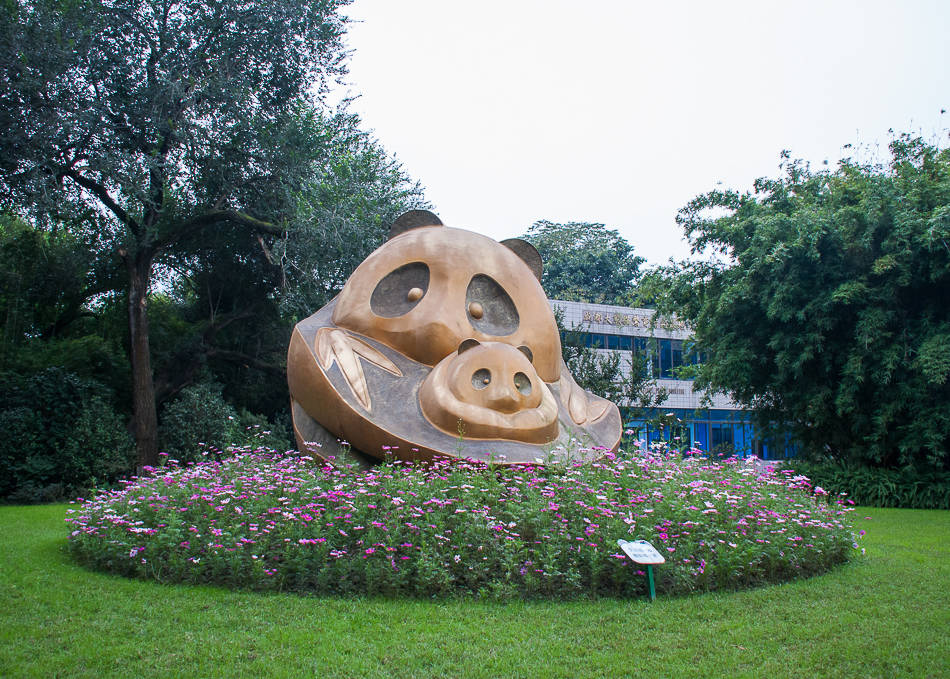Up there with visiting the Great Wall in Beijing and the Terracotta Army in Xian, seeing pandas in China is a must experience for anyone and one you’ll never forget. The easiest place to get up close with the country’s most lovable black and white creature is in Chengdu, China’s western capital.
A 35 minutes taxi ride north from the city center will bring you to the Chengdu Research Base of Giant Panda Breeding, a non-profit organization with the sole aim since 1987 of breeding baby pandas and ensuring their survival to revitalize the decreasing population.
This is no zoo and you’ll realize that the moment you walk into this perfectly landscaped and beautiful park. Located on Futoushan Mountain, the huge conservation base spans 7,000 square metres and was created specifically to provide a comfortable home for the pandas as close to their natural habitat as possible.
Conservation and education are front and center here with the first giant panda museum in the world and you’ll be able to complement your visit with some exhibits and even a stop at the Panda Story Cinema.
The most important thing to know when visiting the pandas is to get up early and reach the base as soon as it opens i.e. around 8am to witness the feeding which usually occurs between 8 and 10am.
It’s such a marvelous thing to see them so close. When I spotted my first black and white shape between the bamboo stalks my heart skipped a beat and it’s almost tiptoeing that I reached the enclosure, my mouth agape in pure amazement.
You have to refrain yourself from extending your arms and trying to rub their belly as it suddenly seems like the most instinctive thing to do in that moment!
I spotted first the teenagers (above, called ‘sub-adults’ at the base and generally between the age of 2 and 5) and then moved on to the larger adults enclosures.
Still pretty much the same crunching and crackling on large supplies of bamboo which they eat between 9 and 14kg daily since bamboo contains such a small level of energy.
This means the majority of their waking hours are spent eating and being fascinatingly carefree in front of all these humans staring at them.
You’ll never forget the sight of pandas covered in a heap of bamboo and eating shreds of it from their bellies – the poster child for gluttony in its most natural form.
They’ll eventually stop when they’ve run out of shoots, and will either laze around or decide to exercise a bit by climbing up trees which they’re excellent at despite their less than agile looking physique.
Seeing them now from every angle, they look rather dirty and not the stark white of your cuddly dreams, but this light brown is actually their real color. Pandas are born hairless and pink, growing white and black fur after a month and this white fur turning brown after about 6 months. Still adorable I’d say…
Walking from one enclosure to the next is a calming experience as you explore the never ending bamboo-lined paths in relative quietness.
Clear signs mark the way to the nurseries, labelled here ‘delivery houses’, where the magic of the panda breeding center truly shines.
The buildings channel pedestrian traffic through a corridor lined with windows offering a glimpse into the captive breeding operations if you come at the right time. Most pandas give birth between August and September and catching a glimpse of the tiny babies is a sight to behold.
This incredible phenomenon is even more poignant to witness when you learn how hard it is for a female panda to breed, most being only able to breed 2-3 days in the year and to only give birth to one cub every two years.
As I visited in early October, I was able to marvel at a few adorable cubs of just under 2 months old, recently able to fully open their eyes as panda babies are born blind for the first few weeks.
Honestly, how freaking cute is this? I swear standing here you’d be able to sell your mother for the chance to pick one up in your arms, and sadly you’ll be quickly rushed through the exit with only a few minutes to snatch a few photos of these adorable creatures.
Previous years’ cubs are playing in the yard, 2-years old getting ready for their own enclosure in due time.
ID panels give an insight into each panda’s details and characteristics, putting a humane touch to the more than 100 pandas living here.
As you continue your stroll around the base, you’ll notice the slowdown in activity with most pandas either lazing around…
…or sleeping soundly as they’re bound to do for the majority of the day. They are indeed one of the laziest animals in the world.
And this is the state of the first sub-adult pandas I first visited, less than two hours later! You’ll be glad you came early as you’re not likely now to see them in any other position, and that’s for the ones that have remained outside as most of them will have retired to their indoor spaces to doze off away from your prying eyes.
Thankfully, there are still a few other inhabitants worth seeking out that are a little less sleepy – the red pandas. The base also care for them as they are an endangered species.
Excellent climbers, you’re likely to spot them up in the trees, either foraging or just sleeping (yes, it’s a favorite pass-time around here).
Despite their adorable look with their cat-like face and cinnamon-red coat, red pandas are notoriously rather feisty and warning signs are put up to discourage anyone from feeding or approaching them.
By 10 or 11am, most activity has died down and while you could linger here a bit more to take advantage of the few cafes and peaceful landscape, there’s a thriving city nearby waiting for you to explore… You’ll be taking those magical two hours with you and cherish those bamboo-eating bears for the rest of your life so get in a cab at the exit for Chengdu. Next post will give you a taste of what the panda capital of the world has to offer besides the cuddly bears!




































SO so so cute
I did want to just squeeze one. But the Red Pandas are my most fav. THose big tails and smart smart face. What a great trip.
Off to the next for you woman of the world.